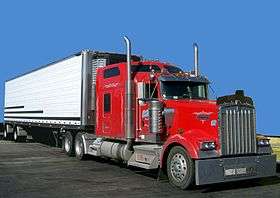United Parcel Service
United Parcel Service (shortened in initials as UPS; stylized in lowercase) is an American multinational package delivery and supply chain management company.[7]
 | |
| Public | |
| Traded as | |
| ISIN | US9113121068 |
| Industry | Courier |
| Founded | August 28, 1907 Seattle, Washington, U.S. as The American Messenger Company |
| Founder | James E. Casey |
| Headquarters | Sandy Springs, Georgia, U.S. |
Area served | Worldwide |
Key people | David Abney (Executive Chairman) Carol Tomé (CEO) |
| Products | Courier express services Freight forwarding services Logistics services |
| Revenue | |
| Total assets | |
| Total equity | |
Number of employees | 481,000 (2018)[2] |
| Subsidiaries | Nightline Group[3][4] Marken[5][6] UPS Logistics UPS Mail Innovations UPS Professional Solutions UPS i-parcel |
| Website | www |
Along with the central package delivery operation, the UPS brand name (in a fashion similar to that of competitor FedEx) is used to denote many of its divisions and subsidiaries, including its cargo airline (UPS Airlines), freight-based trucking operation (UPS Freight, formerly Overnite Transportation), and its delivery drone airline (UPS Flight Forward).[8][9] The global logistics company is headquartered in the U.S. city of Sandy Springs, Georgia, which is a part of the Greater Atlanta metropolitan area.
History
Foundation
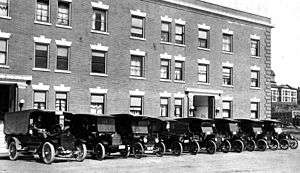
On August 28, 1907, James Casey founded the American Messenger Company with Claude Ryan[10] in Seattle, Washington,[11] capitalized with $100 in debt.[12] Most deliveries at this time were made on foot and bicycles were used for longer trips.
The American Messenger Company focused primarily on package delivery to retail stores with special delivery mail delivered for its largest client the United States Postal Service (USPS). In 1913, the company acquired a Model T Ford as its first delivery vehicle. Casey and Ryan merged with a competitor, Evert McCabe, and formed Merchants Parcel Delivery. Consolidated delivery was also introduced, combining packages addressed to a certain neighborhood onto one delivery vehicle.[12] In 1916, Charlie Soderstrom joined Merchants Parcel Delivery bringing in more vehicles for the growing delivery business. In 1919, the company expanded for the first time outside of Seattle to Oakland, California and changed its name to United Parcel Service. The name change to United Parcel Service was to remind the company expansion that operations were still United under the same organization and Parcel identified the type of business offered as part of its Service. Common carrier service was acquired in 1922 from a company in Los Angeles, California. UPS became one of the only companies in the United States to offer common carrier service. At first common carrier was only limited to a small area around Los Angeles but by 1927 expanded to areas up to 125 miles outside the city. In 1924, a conveyor belt system was debuted for the handling of packages for UPS operations.[13]
In 1930, a consolidated service began in New York City, and soon after in other major cities in the East and the Midwest.[2] The use of common carrier for delivery between all customers placed UPS in direct competition with USPS and the Interstate Commerce Commission. The common carrier service was applied in cities where UPS could use the service without the authority of the ICC and state commerce commissions. The first city for UPS to use common carrier status outside California was Chicago, Illinois in 1953.[14]
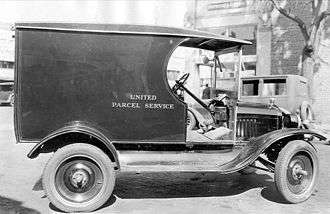
Air service through UPS was first used in 1929 through private airlines. However, The Great Depression and a lack of volume ended the air service. In 1953, UPS resumed air service called UPS Blue Label Air with two-day service to major cities along the East Coast and West Coast.[15]
Expansion and diversification
In 1975, UPS moved its headquarters to Greenwich, Connecticut and began serving all of the 48 contiguous states of the United States. The expanded operations made UPS the first package delivery company to serve every address in the Contiguous United States. UPS went international in 1975 establishing operations in Canada and in 1976 operations were established in Germany. On February 28, UPS Ltd. (later changed to UPS Canada Ltd.) began operations in Toronto, Ontario. UPS Canada's head office is located in Burlington, Ontario. In 1976, UPS established a domestic operation in West Germany.[16]
UPS Next Day Air Service was launched in 1985 for all 48 contiguous states plus Puerto Rico. In 1988, UPS Airlines was launched with authorization from the Federal Aviation Administration. UPS Airlines became the fastest-growing airline in FAA history and today is the 10th largest airline in the United States.[17] Domestic air service was added to Germany in 1989.[18] In 1991, UPS moved its headquarters to Sandy Springs, Georgia, a suburb of Atlanta. In 1992, UPS acquired both Haulfast and Carryfast and rebranded them UPS Supply Chain Solutions. Haulfast provided the pallet haulage and trucking network for the CarryFast group of companies. By 1993, UPS was delivering up to 11.5 million packages and documents per day.
The large volume of UPS customers in the 1990s made UPS develop new technology for better efficiency. A handheld device called Delivery Information Acquisition Device (DIAD) was created to record and upload delivery information to the UPS network immediately upon pickup by every UPS driver. In 1992, UPS began tracking all ground shipments electronically. In 1994, UPS.com debuted, and provided an interface to make what was primarily internal operational information available for customer access. In 1995, UPS acquired SonicAir to offer service parts logistics and compete with Choice Logistics. In the same year, UPS launched UPS Logistics Group to facilitate global supply chain management services and consulting for customer needs. In 1997, a walkout by the 185,000 members of the Teamsters shut down UPS for 16 days.[19] In 1998, UPS Capital was established to enable companies to grow their business through a comprehensive menu of integrated financial services through UPS.[20] UPS acquired Challenge Air in 1999 to expand its operations in Latin America.[21]

On November 10, 1999, UPS became a public company[22] in the largest initial public offering of the century.[23]
21st century
In 2001, UPS acquired Mail Boxes Etc., Inc.[24] In 2003, approximately 3,000 Mail Boxes Etc., Inc. were rebranded as The UPS Store.
In 2004, UPS entered the heavy freight business with purchase of Menlo Worldwide Forwarding, a former subsidiary of Menlo Worldwide. UPS rebranded it as UPS Supply Chain Solutions. The purchase price was US$150 million and the assumption of US$110 million in long-term debt. On August 5, 2005, UPS announced that it has completed its acquisition of less-than-truckload (LTL) trucking company Overnite Transportation for US$1.25 billion.[25] This was approved by the FTC and Overnite shareholders on August 4, 2005. In 2005, UPS offered non-stop delivery service between Guangzhou and the United States.[26] On April 28, 2006, Overnite officially became UPS Freight. On October 3, 2005, UPS completed the purchase of Lynx Express, one of the largest independent parcel carriers in the United Kingdom, for £55.5 million (US$97.1 million) after receiving approval for the transaction from the European Commission. The first joint package car center operation in Dartford, Kent, was opened in 2006.
On August 28, 2007, United Parcel Service celebrated its 100th anniversary.[27] All Nippon Airways, a Star Alliance member, and UPS formed a cargo alliance and code-share to transport member cargo in 2008, similarly to an airline alliance.[28] On March 19, 2012, UPS announced that it intended to acquire TNT Express for $6.8 billion, in a move to help expand its presence in European and Asian markets.[29] However, the deal fell through in January 2013, after it was announced that UPS had failed to obtain permission from the European Commission and as such had been blocked on competition grounds.[30] In February 2012, UPS acquired Brussels-based company Kiala that provides e-commerce retailers the option to have goods delivered to a conventional retail location.[31]
In May 2019, UPS launched a partnership with autonomous trucking startup, TuSimple to carry cargo across Phoenix, AZ and Tucson, AZ. [32]
In October 2019, UPS won the approval of the Federal Aviation Administration to fly drones.[33] The certification will allow UPS to deliver health care supplies using a fleet of drones.[34]
On January 29, 2020 UPS announced it was investing in UK start-up Arrival and ordering 10,000 Generation 2 electric vehicles as a step towards a cleaner, more high-tech fleet. The deal runs from 2020 until 2024 and was reported to be worth more than $400 million.[35]
In March 2020, the company has appointed Carol Tomé to succeed David Abney as its chief executive officer. It was viewed as a move to steer the parcel delivery company through the turbulence of trade wars, technological disruption and the risk of a pandemic-induced recession.[36]
Finances
For the fiscal year 2019, UPS reported earnings of US$4.440 billion, with an annual revenue of US$74.094 billion, an increase of 3.1% over the previous fiscal cycle.[37] UPS ranked No. 41 on the 2019 Fortune 500 list of the largest United States corporations by total revenue.[38]
| Year | Revenue in mil. USD |
Net income in mil. USD |
Total Assets in mil. USD |
Employees |
|---|---|---|---|---|
| 2005 | 42,581 | 3,870 | 34,947 | 407,000 |
| 2006 | 47,547 | 4,202 | 33,210 | 428,000 |
| 2007 | 49,692 | 382 | 39,042 | 425,300 |
| 2008 | 51,486 | 3,003 | 31,879 | 426,000 |
| 2009 | 45,297 | 1,968 | 31,883 | 408,000 |
| 2010 | 49,545 | 3,338 | 33,597 | 400,600 |
| 2011 | 53,105 | 3,804 | 34,701 | 398,000 |
| 2012 | 54,127 | 807 | 38,863 | 399,000 |
| 2013 | 55,438 | 4,372 | 36,212 | 395,000 |
| 2014 | 58,232 | 3,032 | 35,440 | 435,000 |
| 2015 | 58,363 | 4,844 | 38,311 | 444,000 |
| 2016 | 60,906 | 3,431 | 40,377 | 434,000 |
| 2017 | 65,872 | 4,910 | 45,403 | 454,000 |
| 2018 | 71,861 | 4,791 | 50,016 | 481,000 |
| 2019 | 74,094 | 4,440 | 57,857 | 495,000 |
Operations
UPS's primary business is the time-definite delivery of packages and documents worldwide. In recent years, UPS has extended its service portfolio to include less than truckload (LTL) transportation (primarily in the U.S.) and supply chain services. UPS reports its operations in three segments: U.S. Domestic Package operations, International Package operations, and Supply Chain & Freight operations.
U.S. Domestic Package
U.S. Domestic Package operations include the time-definite delivery of letters, documents, and packages throughout the United States.

International Package

International Package operations include delivery to more than 220 countries and territories worldwide,[39] including shipments wholly outside the United States, as well as shipments with either origin or distribution outside the United States.
Supply Chain & Freight
Supply Chain & Freight (UPS-SCS for UPS Supply Chain Solutions) includes UPS' forwarding and contract logistics operations, UPS Freight, and other related business units. UPS' forwarding and logistics business provides services in more than 175 countries and territories worldwide and includes worldwide supply chain design, execution and management, freight forwarding and distribution, customs brokerage, mail and consulting services. UPS Freight offers a variety of less than truckload ("LTL") and truckload ("TL") services to customers in North America.
Other business units within this segment include The UPS Store and UPS Capital.[40]
Personnel structure
UPS employs approximately 444,000 staff: 362,000 in the U.S. and 82,000 internationally.[42] Approximately 240,000 UPS drivers, package handlers and clerks are represented by the International Brotherhood of Teamsters. During the United Parcel Service strike of 1997, the company's only nationwide strike in its history, which lasted 16 days, Teamster President Ron Carey negotiated a new contract for workers.[43]
Chief executives
- 1907–1962, James E. "Jim" Casey
- 1962–1972, George D. Smith
- 1972–1973, Paul Oberkotter
- 1973–1980, Harold Oberkotter
- 1980–1984, George Lamb
- 1984–1989, John W. Rogers
- 1989–1996, Kent C. "Oz" Nelson
- 1997–2001, James P. Kelly
- 2002–2007, Michael L. "Mike" Eskew
- 2008–2014, Scott Davis[44]
- 2014–2020, David Abney
- 2020–current Carol Tomé
Competitors
Major competitors in the United States include United States Postal Service (USPS) and FedEx, along with regional carriers such as OnTrac, and LSO (formerly Lonestar Overnight). In addition to these domestic carriers, UPS competes with a variety of international operators, including Canada Post (and its subsidiary Purolator), TransForce, Deutsche Post (and its subsidiary DHL), Royal Mail, Japan Post Service, India Post and many other regional carriers, national postal services and air cargo handlers (see Package delivery and Mail pages).
Historically, the bulk of competition for UPS came from inexpensive ground-based delivery services, such as Parcel Post (USPS) or Choice Logistics. In 1998, FedEx expanded into ground parcel delivery through its acquisition of RPS (formerly Roadway Package System), rebranding it as FedEx Ground in 2000. In 2003, DHL acquired Airborne Express, expanding its operations in the United States.
In response to the expansion of FedEx and DHL, UPS partnered with the US Postal Service to offer UPS Mail Innovations,[45] a program that allows UPS to pick up mail & packages weighing under one pound separately from the main ground network and transfer them to a USPS center, or destination delivery unit (DDU),[46] for final distribution. This process is also known as zone skipping,[47] long used by Parcel Consolidators.[48] UPS also has a separate product called "SurePost" which uses the UPS Ground network to deliver packages weighing under 10 pounds to the nearest UPS Package Center, which transfers them to the USPS DDU for "final mile" delivery.[49]
More recently, the continued growth of online shopping, combined with increasing awareness of the role of transportation (including package delivery) on the environment, has contributed to the rise of emerging competition from niche carriers or rebranded incumbents. For instance, the US Postal Service claims "greener delivery" of parcels on the assumption that USPS letter carriers deliver to each US address, six days a week anyway, and therefore offer the industry's lowest fuel consumption per delivery. Other carriers, like ParcelPool.com,[50] which specializes in residential package delivery to APO/FPO addresses, Hawaii, Alaska, Puerto Rico, and other US Territories, arose in response to increased demand from catalog retailers and online e-tailers for low-cost residential delivery services closely matching service standards normally associated with more expensive expedited parcel delivery.
Transportation
UPS operates over 119,000 delivery vehicles worldwide, ranging from bicycles to tractor-trailer trucks.[51] In a long-running company policy to avoid advertisement or endorsement of a vehicle manufacturer, all external manufacturer emblems and badging are removed when a vehicle enters service (whenever possible).
The typical lifespan of a UPS ground vehicle is 20–25 years (or more), lasting until the structural integrity is compromised. The company does not re-sell any of its ground vehicles, so retired vehicles are almost always stripped of reusable parts before being sent to be crushed/broken up. Prior to scrapping, UPS trucks and trailers have all company branding painted over and are assigned an ADA (Automotive Destruction Authorization) number and must be crushed under the supervision of UPS Automotive personnel, which records the vehicle's destruction. The only exception to this policy are vehicles taken off the road for internal use; package cars (repainted white) are used for various purposes (typically at large hubs); older semitractors sometimes see use as terminal tractors.
Delivery vans
UPS refers to its delivery van as a "package car". Several designs and sizes are used by the company, dependent on routes and package volume.
Morgan Olson (Grumman Olson), Union City Body, and Utilimaster manufacture the bodies for UPS delivery vans. While older vehicles were based on Ford or General Motors P-chassis, vehicles manufactured since the 1990s are based on Navistar, Freightliner, or Workhorse chassis. Originally, UPS delivery vehicles were equipped with manual transmissions and steering, although many newer vehicles are updated with automatic transmissions.
For lower-volume delivery routes, UPS utilizes production-based vehicles, including minivans (including the Ford Transit Connect and Dodge Grand Caravan C/V) and Mercedes-Benz (Dodge/Freightliner) Sprinter box vans. UPS has ordered Modec electric vans for its UK and German fleets. Energy costs play a huge part in the potential profitability of package delivery companies.[52]
.jpg) 1990s Grumman Olson/Navistar package car, showing 1965-design rounded nose and upper fascia
1990s Grumman Olson/Navistar package car, showing 1965-design rounded nose and upper fascia 2000s propane-fueled package car in Montreal, Quebec.
2000s propane-fueled package car in Montreal, Quebec.- Early 2010s package car in Ontario
%2C_NYC.jpg) Utilimaster-body package car on Isuzu Reach chassis in New York City
Utilimaster-body package car on Isuzu Reach chassis in New York City_16.jpg) Ram ProMaster package car
Ram ProMaster package car Modec electric-powered van in Germany
Modec electric-powered van in Germany Iveco Daily package car in Leamington Spa, United Kingdom
Iveco Daily package car in Leamington Spa, United Kingdom
Most package cars have no air conditioning, with the exception of tractor-trailers. This has been considered to be a contributing factor to heatstroke and other heat-related health problems in drivers who work in these vehicles for the entire shift.[53][54][55]
On January 29, 2020, UPS invested in Arrival (company) and ordered 10,000 Generation 2 Electric Vehicles.[56]
Tractor-trailers
UPS commonly refers to its ground package tractor-trailers as "feeders"; these vehicles are distinct from the UPS Freight fleet. In line with its delivery vehicles, nearly all UPS tractor units are painted in a Pullman brown livery. Prior to the 1990s, many tractors were of cabover configuration; as trailer-length laws were revised in the United States, the company transitioned towards the use of conventional-style semitractor. As of 2018, nearly the entire UPS semitractor fleet consists of conventional-cab trucks.
In North America, UPS utilizes a fleet of trucks from several manufacturers, including Mack Trucks (Pinnacle and Vision) and Navistar (International ProStar+ and 9900i), along with PACCAR vehicles (Kenworth T800, T660 and T680). Older vehicles in the fleet include Ford/Sterling tractors (Aeromax/A-Line), Freightliner (Argosy, the final cabover truck used by UPS); Mack CH and International 8100 tractors are in the process of being phased out.
Previous trucks used by UPS include the Ford L9000, Ford Aeromax, International 8100/8200, International 9670, GMC Astro, Peterbilt 362, Ford L9000, Ford Aeromax, WhiteGMC High Cabover/Road Commander II, Mack CH, Mack MH UltraLiner, Mack F, and Diamond T/Diamond Reo cabovers. At one time, UPS used electric-powered trucks (made by White Motors) for deliveries in Manhattan, NYC. There were only a few hundred of them, but they were notable for their "spooky silence" when running.
Painted a light gray, company-owned semitrailers are distinguished by a large UPS emblem on the forward portion of the trailer sides; newer trailers are distinguished by the fitment of trailer skirts. Designed in several configurations, UPS uses several lengths of trailers (28, 45, 48, and 53 feet). Along with standard flat-bottom van trailers, there are drop-frame trailers (largely phased out of the fleet) and trailer-on-flatcar trailers (TOFC); the latter are trailers designed for transport on railroad cars.
Dependent on state and provincial regulations, many UPS short trailers are towed in tandem.
.jpg) UPS 1990 Ford LN8000 in Seattle, Washington.
UPS 1990 Ford LN8000 in Seattle, Washington.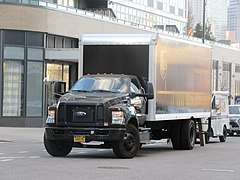 2017 Ford F-650 in New York City
2017 Ford F-650 in New York City.jpg) UPS International 9000 towing triple trailers in Beatty, Nevada.
UPS International 9000 towing triple trailers in Beatty, Nevada. UPS DAF LF cabover straight truck in Plymouth, United Kingdom
UPS DAF LF cabover straight truck in Plymouth, United Kingdom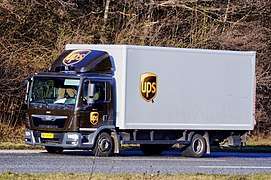 UPS MAN TGL truck in Denmark
UPS MAN TGL truck in Denmark
Bicycles
In 2008, UPS started hiring bicycle delivery personnel in Vancouver, Washington, and in several cities in Oregon (Portland, Salem, Corvallis, Eugene, and Medford).[57] In fall of 2018, UPS announced a new program in Seattle, Washington using pedal-assist electric cargo bikes (made by Portland-based Truck Trike) around Pike Place and other congested downtown areas. [58][59] In Amsterdam UPS also uses Urban Arrow delivery bicycles for delivery via a granted concession. [60]
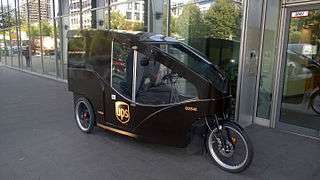 UPS e-drive electric-assisted cargo tricycle in Hamburg, Germany
UPS e-drive electric-assisted cargo tricycle in Hamburg, Germany UPS e-drive electric-assisted cargo tricycle in Cologne, Germany
UPS e-drive electric-assisted cargo tricycle in Cologne, Germany
Trains
UPS contracts with several railroad companies in the United States to provide intermodal transport for its cargo.
Cargo airline
_-_Boeing_747-45E(BCF)_-_HKG_(13219958434).jpg)
The fourth-largest cargo airline worldwide, UPS Airlines flies to over 800 destinations worldwide (the most of any airline, cargo or passenger). Formed in 1988, the airline is headquartered in Louisville, Kentucky (home to Worldport, its worldwide air hub) with additional hubs in the United States located in Rockford, Illinois and Philadelphia.[51] Outside of North America, a hub in Cologne, Germany services Europe;[61] in Asia, UPS Airlines operates a facility in Hong Kong and two hubs in mainland China.[51][62]
Consisting of a fleet of over 260 aircraft,[62] the airline competes directly against FedEx Express, facilitating air shipments by the company in over 200 countries and territories worldwide.[61]
Cargo drone airline
UPS Flight Forward is a subsidiary which was formed in July 2019[63] and approved by FAA for Part 135 Standard certification, first ever to receive this specific type of certification. The FAA's Part 135 Standard certification allows company to operate an unlimited number of drones of any size (even allowing the cargo to exceed 55 pounds) even at with an unlimited number of remote operators in command.[64]
Company brand
.svg.png)
.svg.png)

Brown
The brown color that UPS uses on its vehicles and uniforms is called Pullman brown. Company founder James E. Casey originally wanted company vehicles to use a yellow paint scheme, but one of his partners, Charlie Soderstrom, stated that a yellow vehicle would be hard to keep clean and that Pullman railroad cars were brown for just that reason.[10]
During the 2000s, the company used the familiarity of its color scheme in an advertising slogan: "What can Brown do for you?"[65]
Font
UPS commissioned brand consultancy FutureBrand to develop its own font, UPS Sans, for use in marketing and communication material. UPS Sans was created by slightly altering certain parts of FSI FontShop International's font FF Dax without permission. This has resulted in an agreement between FSI FontShop International and FutureBrand to avoid litigation.[66]
Environmental record
As of 2013, UPS has over 104,900 vehicles in operation worldwide including nearly 7,000 alternative-fuel vehicles.[1] In May 2008, UPS placed an order for 200 hybrid electric vehicles (adding to the 50 it had at that point) and 300 compressed natural gas (which are 20% more fuel efficient, and add to the 800 it already has) vehicles from Daimler Trucks North America.[67][68][69] The company added 200 hybrid electric vehicles to its fleet in 2016.[70]
UPS received a "striding" rating of 80 points out of 100 totals on the environmental scorecard by the Climate Counts Group for its efforts to lessen the company's impact on the environment.[71] UPS has also been awarded the Clean Air Excellence Award by the United States Environmental Protection Agency because of the alternative fuel program it has developed.[72]
In October 2009, UPS became the first small-package carrier to offer customers the chance to buy carbon offsets to neutralize the greenhouse gas emissions generated by the transport of their packages. Although initially only available on ups.com and to high-volume shippers, they are now widely available through UPS shipping systems and UPS Ready third-party shipping systems.[73][74]
Controversy
On May 26, 2017, a federal judge ordered United Parcel Service to pay nearly $247 million in damages and penalties for illegally shipping large amounts of untaxed cigarettes in New York.[75]
See also
- Big Brown – 2008 Kentucky Derby and Preakness Stakes winner; named after the company
- MaxiCode – A UPS developed and utilized square barcode-like symbol that appears on their package label
- James E. Casey - Founder of UPS
References
- "UPS Fact Sheet". Globenewswire. Retrieved February 28, 2019.
- "The UPS Logo – A Brief History". UPS Pressroom. Archived from the original on April 5, 2010. Retrieved February 15, 2010.
- Taylor, Charlie (May 3, 2017). "Parcel Motel owner Nightline acquired by delivery firm UPS". The Irish Times. Retrieved August 7, 2018.
- "UPS to Acquire Ireland-based Nightline Logistics GROUP". nightline.ie. Retrieved August 7, 2018.
- "Exhibit 21 - Subsidiaries Of United Parcel Service, Inc. As of December 31, 2017". U.S. Securities and Exchange Commission. Retrieved August 7, 2018.
- "UPS Completes Acquisition Of Marken". Marken.com. Retrieved August 7, 2018.
- "." SEC 2017 Form 10-K Item 1 Business Overview.
- "UPS starts Distributing its Delivery Packages with Drones". UPSers. Retrieved July 16, 2018.
- "UPS Employee Programs". UPSers.online. Retrieved July 16, 2019.
- Paul Lukas Reporting by Maggie Overfelt (April 1, 2003). "UPS United Parcel Service James Casey like pie". CNN. Retrieved December 18, 2010.
- "UPS: 1907–1929". ups.com. Retrieved June 24, 2016.
- Warren, James R. (September 20, 1999). "United Parcel Service (UPS)". HistoryLink. Retrieved February 21, 2016.
- "1907–1929". ups.com. Retrieved February 12, 2017.
- "Company History 1930–1980". UPS. Retrieved July 4, 2017.
- "Air Service". UPS.com. Retrieved February 12, 2017.
- "History Timeline". www.pressroom.ups.com.
- "UPS History Timeline". UPS. Retrieved June 24, 2016.
- "UPS Airlines". UPS.com. Retrieved February 12, 2017.
- "It's official: Teamsters end UPS strike". CNN. August 20, 1997. Retrieved December 4, 2013.
- "1991–1999". UPS.com. Retrieved February 12, 2017.
- Bloomberg News (June 29, 1999). "UPS Agrees to Buy Challenge Air Cargo Assets". Los Angeles Times. ISSN 0458-3035. Retrieved December 23, 2015.
- Isidore, Chris (November 10, 1999). "UPS soars past record IPO". CNN Money. Retrieved February 12, 2017.
- Gilpin, Kenneth N. "Workers Ready to Cash In as U.P.S. Goes Public". Retrieved August 30, 2018.
- Amy Doan (March 5, 2001). "UPS Picks Up Mail Boxes Etc". Forbes.
- "UPS Completes Acquisition of Overnite". UPS Press Release. Archived from the original on September 28, 2007. Retrieved August 17, 2007.
- Campanelli, Melissa (April 7, 2005). "UPS Starts Nonstop Flights to Guangzhou". DM News. Retrieved February 12, 2017.
- Weber, Harry (August 4, 2007). "UPS celebrates its 100-year anniversary". USA Today. Retrieved February 12, 2017.
- "All Nippon Airways and UPS to work together amid cargo slump". October 29, 2008. Retrieved December 18, 2010.
- "UPS to Purchase TNT Express for $6.8 Billion". Businessweek. March 19, 2012. Retrieved June 21, 2012.
- "Major Express Freight and Logistics Merger Torpedoed by European Commission". Handy Shipping Guide. Retrieved January 15, 2013.
- Berman, Jeff (February 16, 2012). "UPS expands B2C presence with Kiala acquisition". Logistics Management. Retrieved February 12, 2017.
- O'Kane, Sean (2019-08-15). "UPS has been quietly delivering cargo using self-driving trucks". The Verge. Retrieved 2019-08-29.
- Martin, Ken (2019-10-02). "UPS gets government approval to fly drones". FOXBusiness. Retrieved 2019-10-02.
- Garcia, Sandra E. (2019-10-02). "F.A.A. Allows U.P.S. to Deliver Medical Packages Using Drones". The New York Times. ISSN 0362-4331. Retrieved 2019-10-06.
- Alan Ohnsman (2021-01-29). "UPS Jumps Into The Future With Plan To Buy 10,000 Electric Vans And A Waymo Self-Driving Delivery Pilot". Forbes. Retrieved 2020-01-30.
- https://www.ft.com/content/35ca87f6-6463-11ea-b3f3-fe4680ea68b5
- "UPS Revenue 2006-2018 | UPS". www.macrotrends.net. Retrieved October 30, 2018.
- "Fortune 500 Companies 2018: Who Made the List". Fortune. Retrieved November 10, 2018.
- "UPS Fact Sheet". Retrieved June 24, 2016.
- The former name for The UPS Store was Mail Boxes Etc., which continues to operate outside the United States and Canada. The UPS Store, Inc. is the franchisor for The UPS Store in the U.S. and Canada. "UPS Sells Off MBE Brand outside US, Canada and India". Archived from the original on September 3, 2012. Retrieved November 10, 2010.
- Roberts, Earl W.; Stremes, David P. (2009). Canadian Trackside Guide. Ottawa, Ontario: Bytown Railway Society. pp. Chapter 18 Page 27.
- "UPS Fact Sheet". ups.com.
- "It's official: Teamsters end UPS strike". CNN. Retrieved August 19, 2007.
- "UPS Chairman & CEO Mike Eskew to Retire; Scott Davis Named as Successor". Archived from the original on October 17, 2007.
- UPSmailinnovations.com. UPSmailinnovations.com. Retrieved on July 12, 2011.
- PE.usps.gov Archived July 5, 2007, at the Wayback Machine. PE.usps.gov. Retrieved on July 12, 2011.
- Multichannelmerchant.com. Multichannelmerchant.com (January 18, 2006). Retrieved on July 12, 2011.
- Shipping Consolidators. USPS.com. Retrieved on January 2, 2013.
- "UPS rolls out new economy ground service for delivery to residential locations". logisticsmgmt.com. April 11, 2011.
- Parcelpool.com. Parcelpool.com. Retrieved on July 12, 2011.
- "UPS Fact Sheet". UPS Pressroom. Retrieved September 11, 2018.
- "Europe: UPS Orders Modec Electric Vans for UK and German Fleets". November 20, 2008. Retrieved December 18, 2010.
- Visram, Talib (2 August 2018). "UPS doesn't air condition its trucks. This petition aims to change that". CNNMoney. Retrieved 21 August 2019.
- "UPS Workers Push For Air-Conditioned Trucks, More Regulations on Heat Exposure -". Occupational Health & Safety. Retrieved 21 August 2019.
- "UPS delivery drivers at risk of heat-related illnesses". NBC News. Retrieved 21 August 2019.
- https://arrival.com/news/ups-invests-in-arrival-and-orders-10000-generation-2-electric-vehicles
- Maus, Jonathan (November 14, 2008). "UPS gears up for holidays with bike delivery". Retrieved December 18, 2010.
- "UPS is experimenting with delivering packages by e-bike". Fast Company. October 25, 2018. Retrieved October 28, 2018.
- "Portland-made Truck Trike stars in UPS cargo delivery pilot program in Seattle - BikePortland.org". BikePortland.org. October 25, 2018. Retrieved October 28, 2018.
- https://parcls.com/en/
- "UPS Airlines, Inc.: Private Company Information - Bloomberg". 2017-02-14. Archived from the original on February 14, 2017. Retrieved 2019-12-23.
- "United Parcel Service (UPS) Fleet Details and History". planespotters.net. Retrieved February 13, 2017.
- "UPS forms a new subsidiary for drone delivery and seeks FAA approval to fly". TechCrunch. Retrieved 2019-10-01.
- "UPS gets FAA approval to operate an entire drone delivery airline". TechCrunch. Retrieved 2019-10-01.
- "UPS Launches Biggest, "Brownest" Ad Campaign Ever". Archived from the original on November 2, 2002.
- "FontShop and Unnamed Firm Reach Agreement". FSI Press Release. Archived from the original on July 4, 2008. Retrieved May 22, 2008.
- "green-fleet".htm "UPS orders 500 vehicles for green fleet". Canadian Driver. May 14, 2008. Retrieved December 18, 2010.
- "UPS Places Largest Order for "Green" Trucks Ever with Daimler Trucks North America (DTNA)". finchannel.com. May 15, 2010. Retrieved December 18, 2010.
- "UPS orders more hybrid electric trucks". East Bay Business Times. May 13, 2008.
- "UPS Adds 200 Hybrid Electric Vehicles To Alternative Fuel Fleet". UPS Pressroom. Retrieved May 16, 2018.
- UPS Score Archived October 22, 2016, at the Wayback Machine Climate Counts. Retrieved on August 8, 2018.
- UPS Environmental Achievements Recognized by EPA; UPS Improves Air Quality through Environmental Programs. CSRwire.com (April 6, 2006). Retrieved on July 12, 2011.
- "Interview: Scott Wicker, VP Sustainability, UPS on UPS's Per-Package Carbon Offsets Service". CarbonOffsetsDaily.com. October 13, 2009.
- Shipping carbon neutral with UPS Archived August 16, 2011, at the Wayback Machine UPS. Retrieved on July 12, 2011.
- "UPS Fined $247M for Illegally Shipping Cigarettes". NBC News. Reuters. May 26, 2017.
Further reading
- Allen, Joe. The Package King: A Rank and File History of UPS. Chicago: Haymarket Books, 2020.
- Brewster, Mike and Frederick Dalzell. Driving Change: The UPS Approach to Business (2007) excerpt and text search
- Thomas L. Friedman, "Insourcing," in The World Is Flat: A Brief History of the Twenty-First Century, New York: Farrar, Straus and Giroux, updated and expanded, 2006, pp. 167–176.
- Minchin, Timothy J. "Shutting Down 'Big Brown': Reassessing the 1997 UPS Strike and the Fate of American Labor," Labor History, 53 (Nov. 2012), 541–60.
- Niemann, Greg. Big Brown: The Untold Story of UPS. New York: John Wiley & Sons, 2007.
External links
| Wikimedia Commons has media related to United Parcel Service. |
- Business data for United Parcel Service:
- How Courier Company UPS Operate on YouTube
- Yahoo! – United Parcel Service, Inc. Company Profile
